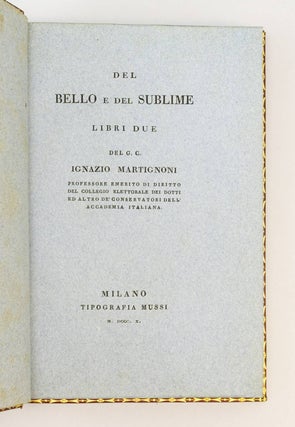DEL BELLO E DEL SUBLIME.
(Milan: Tipografia Mussi, 1810). 227 x 145 mm. (9 x 5 3/4"). 142, [2] pp. FIRST EDITION, possibly a unique copy printed on blue paper.
SUPERB CONTEMPORARY RED STRAIGHT-GRAIN MOROCCO, GILT, BY LODIGIANI (his ticket on verso of front free endpaper), covers with gilt palmette-and-crescent roll border and delicate frame of plain and stippled rules, smooth spine divided into compartments by a gilt-rule-and-rosette roll, compartments densely gilt with rows of interlocking circlets, gilt titling, gilt-rolled turn-ins, marbled endpapers, all edges gilt. For the binding: Schiff IV, 75. ◆A touch of chafing to boards, some foxing to flyleaves, tail edge of one leaf with small chip, otherwise A VERY FINE COPY, clean and fresh internally, in a very well-preserved, especially lustrous binding.
This rare work on the differences between the beautiful and the sublime comes in an especially pleasing binding by the greatest Italian binder of the day. Luigi Lodigiani (1766–1846) was working in Paris in the early years of the 19th century, when the Bozerian bindery was at its zenith, and his work shows the influence of that illustrious workshop. He later settled in Milan, where his clients included Archduke Rainer of Austria, Emperor Francis I, and Eugène de Beauharnais, Napoleon's stepson and Viceroy of Italy, as well as numerous Italian nobles. Our binding is quite similar to that pictured on p. 157 of De Ricci's "British and Miscellaneous Signed Bindings in the Mortimer L. Schiff Collection," differing only in the use of circlets rather than scallops for the spine decoration, and the presence of a supralibros (of the Trotti-Betivoglio family) on the Schiff exemplar. This beautiful binding covers a discussion on aesthetics by Ignazio Martignoni (1757-1814), who studied law at the University of Pavia but spent most of his career writing on the arts and architecture. Martignoni classified applied or mechanical arts as those driven by necessity and arts like poetry, painting, music, and dance as engendered by the desire for pleasure, while architecture combines elements of both, being both useful and beautiful. In this treatise he contrasts beauty, which gives pleasure, to the sublime, which adds to the pleasure a sense of wonder and awe. Our copy is printed on blue paper, which had been used for "special" copies of Italian books since the days of Aldus Manutius, who is thought to have printed the first book on blue paper in 1514. Our first edition is rare, with no copy traced at auction for at least 40 years, and we have been unable to locate another copy on blue paper. The special paper and the elegant binding suggest that this copy was intended for presentation, or at least was owned by a person of considerable importance. (ST15088b)
Price: $2,900.00


